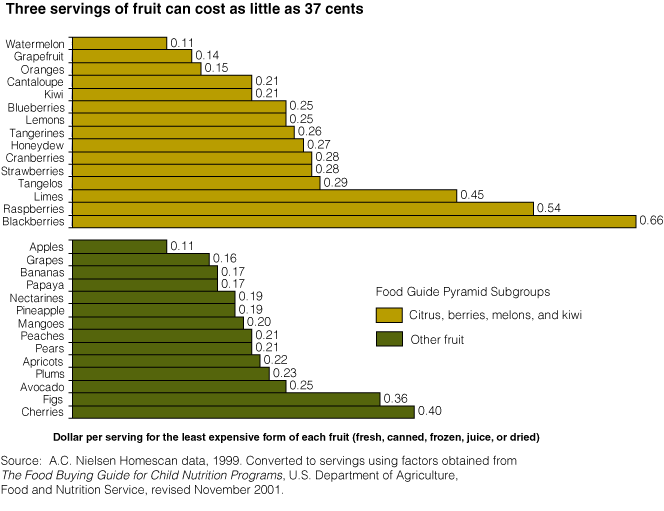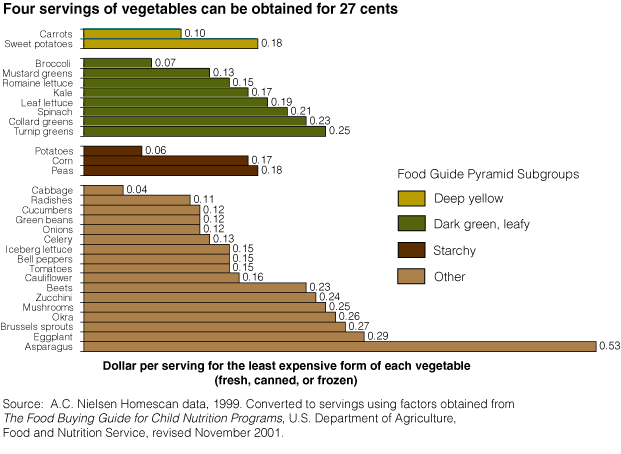How Expensive Are Fruits and Vegetables Anyway?
- by Jane Reed and Elizabeth Frazão
- 9/1/2004
Many Americans do not consume the recommended amounts of fruits and vegetables. Almost half of Americans think eating more fruits and vegetables would make their diets healthier, so why don’t they? One argument is that fruits and vegetables are expensive, especially when purchased fresh. According to an ERS study, consumers can eat three servings of fruit and four servings of vegetables for 64 cents a day, which represents 12 percent of daily food expenditures per person.
ERS researchers used 1999 household purchase data from all types of retail outlets to estimate an annual, national retail price per pound for 69 fresh and processed fruits and 85 fresh and processed vegetables. Since the purchase weight of many fruits and vegetables include rinds, seeds, and other nonedible parts, researchers also estimated the number of edible servings per pound. More than half of the fruits and vegetables were estimated to cost 25 cents or less per serving in 1999. Eighty-six percent of the vegetables and 78 percent of the fruit cost less than 50 cents a serving—that’s 127 different ways to eat a serving of fruits and vegetables for less than the price of a 3-ounce candy bar.
Are fresh fruits and vegetables more expensive to eat than processed? According to this study, definitely not. On a per serving basis, almost two-thirds of all fruit and more than half of all vegetables were less expensive in their fresh form than in their processed form. Even so, the difference in price per serving between the least and most expensive versions for many fruits and vegetables was often less than a quarter. For some consumers, this additional amount may be a small price to pay for the longer shelf life, ease of preparation, and greater availability associated with processed forms. Expectations that fresh produce will go bad and be thrown out may fuel consumers’ perception that fresh produce is more expensive than processed.
Consumers need to be savvy and consider not only the price per pound but the number of servings obtainable from a pound, which varies considerably among different fruits and vegetables. Some consumers may balk at paying $2.53 for a pound of dried apricots when the per pound cost for either fresh or canned apricots is a dollar less. What they may not realize is that a pound of dried apricots contains 11 servings, while a pound of fresh apricots provides 6 servings, and a pound of canned only 4, making dried apricots cheaper than either fresh or canned on a per serving basis.
This study uses 1999 prices, so today’s prices would be about 10 percent higher on average. These prices reflect averages and are not the same prices that any household might face on a given day. The point of purchase—for example, a farmers’ market versus a supermarket—will affect the price. In-store sales, coupons, and the brand selected also affect the price. In addition, lower per pound costs are often associated with purchasing larger containers. For fresh produce, in particular, the time of year (seasonality) may impact the price an individual pays for a particular item. Yet, for most Americans, cost need not be a barrier to consuming the recommended amounts of fruits and vegetables.
This article is drawn from:
- Reed, J., Frazão, E. & Itskowitz , R. (2004). How Much Do Americans Pay for Fruits and Vegetables?. U.S. Department of Agriculture, Economic Research Service. AIB-790.



